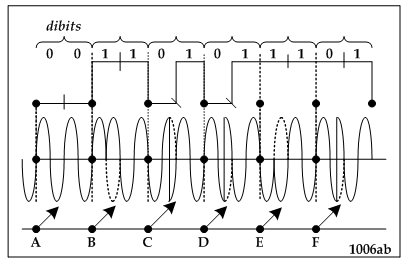What is exactly a baud? Is it the same as bits per second?
(deleted)
A Google search on;
Wiki Baud
Will, shock horror, direct you to the Wikipedia page which explains quite a bit about baud.
Is it the same as bits per second?
No.
michalt38:
What is exactly a baud? Is it the same as bits per second?
Baud (Bd) refers to 'information' being conveyed by a carrier/channel and is proportional to the change in one of many characteristics of the carrier. On the other hand, bit rate is the number of physical bits being transferred per second over a communication channel, which may be equal to Bd (in the case of UART based Serial Communication) or not. Let us try to understand the difference between Bd and bit rate with reference to Bell 212A type Modem (now probably defunct; but, the concept remains the same).
Bell 212A type modem uses 1200 Hz sine wave carrier for transmission and 2400 Hz sine wave carrier for reception. It uses the so called ‘dibit encoding’, where ‘2 consecutive bits’ in the data stream is treated together. In this scheme, the value of these two bits determines the amount of phase shift to be occurred in the carrier. The relationship is:
dibit value phase shift
00 00
01 900
10 1800
11 2700
Now, assume that the bit pattern 001101101001 would be transmitted using the dibit encoding scheme. The relationship between the values of the dibits and the phase shifts of the carrier is depicted below in Fig-1. The value of the 1st dibit is 00, so there is no phase shift of the carrier. The value of the 2nd dibit is 11, so the phase shift of the carrier is 1800and it has occurred at the elapse of 1800 from point B. In a similar way, we have indicated the phase shift points for the remaining dibits of the data stream.
Now, we are in a position to explain the difference between the bit rate and the baud rate, the concepts exist in the serial communication. Assume that the carrier frequency is 1200Hz. One cycle period is required for the shifting of 1-bit data into the phase-shift keying modulator. Thus the bit rate is:
Bit rate = (12 /12) x 1200 = 1200 bits/sec
Now, look at the carrier of Fig-1, we observe that there is only 6 changes in the carrier. Thus the baud rate would be only half of the bit rate and it is: 600 Bd.

Figure-1:
The telephone network, that we use for data communication has the bandwidth limited to 300 Hz – 3KHz. Therefore, it is inhibited to increase the data transmission rate by increasing the carrier frequency. Increased data transmission rate means increased bits/sec. If this is the case and we use dibits encoding system, then there would occur more changes in the carrier, which ultimately may exceed the bandwidth of the telephone lines. Therefore, the goal is to be sending more data bits with less baud rate. This is possible by using higher encoding system like ‘tribit encoding’.
In the tribit-encoding scheme, 3-bits data are treated together and the phase shifts in the carrier occur at 450 apart for eight possible combinations of the tribit. The Bell 208 modem uses the tribit scheme to transmit data at 4800 bits/sec using baud rate of only 1200 Bd.
There is another scheme known as ‘Quaternary Amplitude Modulation (QAM)’, which makes possible to transfer data at 9600 bit/sec using only 2400 bd.
Note: Now in the light of the above discussion, one can figure out why the Bd and bit rate in asynchronous serial communication are the same.

Sigh - you guys... You know what he's asking about!
michalt38:
What is exactly a baud? Is it the same as bits per second?
In practical terms, assuming you're talking about UART serial (which is where most Arduino folks encounter the term), baud rate is bits per second - but remember that there is a start bit and a stop bit for every byte (assuming typical settings - there can also be two stop bits)